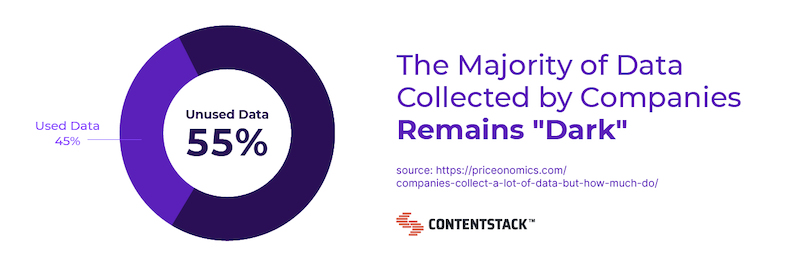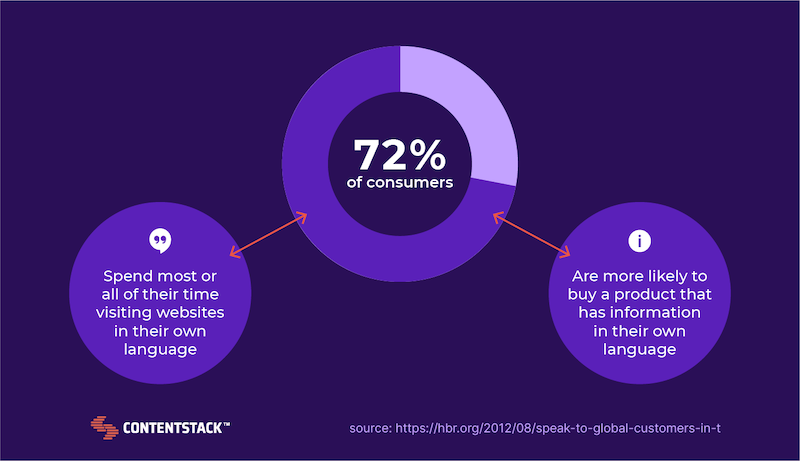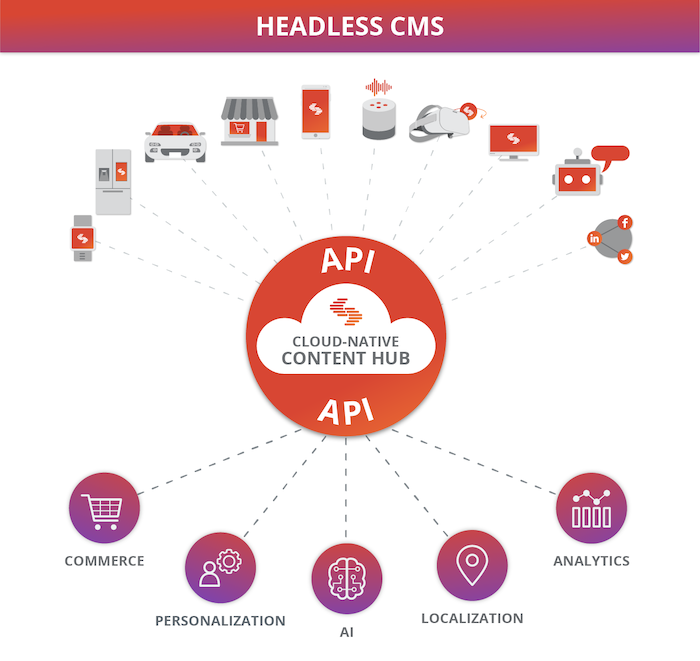There are many angles to consider for marketing managers in enterprise firms when evaluating a content management system: How does what you currently have compare to what’s on the market? How much longer can your company live with the functionality you’re locked into? And if you choose to invest in something different, how can you be sure it will be worth it?

There’s a lot at stake in today’s fast-paced and competition-rich business environment when choosing a content management system (CMS) for your enterprise. This is especially true for firms with a growing number of employees, customers, leads, and pieces of content to manage.
In this guide, we’ll help marketing managers learn everything they need to know about enterprise CMS, including:
- Why an enterprise CMS specifically is key
- Why it’s essential to take your time to choose a good fit for your organization
- Important factors to consider when you’re shopping for an enterprise CMS
- How to implement the enterprise CMS of your choice
- A few resources that will help you learn more about the world of enterprise CMS
It all starts with understanding enterprise CMS at its core.
What Is Enterprise CMS?
A content management system is a software application that enables businesses to create, manage, and publish content for their websites, applications, and other digital experiences.
As a central hub and a publishing engine for marketing content, the CMS is central to the success of any business’ marketing team. This is why it’s important for marketing leaders at enterprise organizations to choose an enterprise CMS specifically.
An enterprise CMS is a content management system that’s equipped with the features and capabilities enterprise marketing departments need to engage prospects and ultimately drive revenue.
With the right enterprise CMS, your marketing department can execute a successful enterprise content management (ECM) strategy. ECM is the process of managing and applying content throughout its lifecycle to support employees and furthers business goals. With that in mind, let’s explore more critical reasons why it’s so important to choose the right enterprise CMS for your business.
Why Choosing a Great Enterprise CMS Matters for You
Over 60% of websites use a content management system. The following benefits show you why choosing the right CMS matters to most businesses that have an internet presence — and why it should matter to you.
Enterprise CMS Can Boost Traffic to Your Website
Any worthwhile modern CMS, especially an enterprise CMS, comes with features and ready-made integrations to boost your search engine presence, such as:
- Page titles
- Meta descriptions
- Optimized URL structures
- Alt text for images
- Breadcrumb navigation
- XML sitemaps
- Redirect capabilities
Simply publishing your content from an enterprise CMS with these features can give you a leg-up when it comes to the race to the top of Google’s search results.
Streamline Collaboration to Power Productivity
Most marketing organizations don’t struggle to produce enough content — they struggle to manage it productively. A successful enterprise CMS keeps content organized and permissions flexible so that contractors and staff from across departments and even across the world can access, optimize, and publish the content they need to, whenever and wherever they need to. Now that’s productive.
Implement Much-Needed Information Governance
Data breaches, privacy regulations, and industry compliance measures are becoming more common as more business takes place online. Enterprise CMS platforms provide information governance and highly-customizable permissions settings that help enterprises keep up while remaining secure.
Enterprise CMS Shines a Light on Dark Data
Enterprises must integrate their content marketing efforts with business intelligence applications to help make informed business decisions.
Unfortunately, research shows that more than half of the data collected by companies is “dark” data — that is, information that never sees the analytical light of day and never contributes to business intelligence.

Why do enterprise content marketers face these hurdles? Because they’re still working with outdated monolithic CMS platforms designed in a time before 24/7, omnichannel, personalized experiences were table stakes — a time when content was primarily static and almost always only published once to a single webpage.
These traditional CMSs were often “store-bought,” but some were custom made. Whichever the case, recent developments in content trends have quickly made many of these solutions nearly obsolete. Today, traditional CMS platforms lack the functionality and flexibility they need to keep up with large-scale business shifts and growth.
Outgrowing a CMS doesn’t necessarily happen all at once. But if the following scenario sounds familiar, it’s probably happening to you:
Maybe your existing CMS has started showing signs of aging — your IT team is spending way more time on security patching and bug fixing. At the same time, your content creators and editors complain more often about slow load times, clunky processes, and broken plug-ins. Maybe you’ve noticed it’s getting increasingly expensive and time-consuming to find the add-ons and workarounds you need to meet the growing demands of an omnichannel marketing environment. And maybe if you read one more email about “Why can’t our system do [insert cool new-fangled feature]?!” you might just take a baseball bat to your computer.
If this sounds like you, put down the bat and start shopping for your modern enterprise CMS solution today. Here’s everything you need to know to do just that.
6 Features to Look for When Choosing an Enterprise CMS for Your Organization
Next up: The features your enterprise CMS should have to live up to your modern needs.
Omnichannel Content Distribution
Chances are your enterprise needs to manage content for multiple websites, ecommerce stores, and marketing campaigns at the same time.
If that’s the case, you need a CMS that can handle more than just pushing content to a single, static website. You need an enterprise CMS that seamlessly integrates with all of your social media channels, mobile apps, IoT devices, chatbots, and other as-yet-unheard-of technologies where your content can live.
A headless enterprise CMS (more on that later) is especially effective for empowering omnichannel enterprises with a modular architecture that makes content re-use, optimization, and distribution simple.
Multi-Language Capabilities
Personalization is increasingly essential to engage customers in a meaningful way, especially for brands that operate in more than one country. Having an enterprise CMS that can handle multi-language content, including incorporating translation and localization tools, helps ensure that you can deliver the right content in the right context no matter where in the world it’s needed.

Automation Through Integration
As your enterprise grows, so does your content workload — which is a great reason to implement automation to do more of the heaving lifting. Through integrations with artificial intelligence-enabled tools, an enterprise CMS can empower content teams to take advantage of technology to automate routine tasks that generally take humans a lot of time.
For example, automation can help you process a massive amount of images in the blink of an eye. It can help manage your content lifecycle by flagging content that needs refreshing and even predict which leads have the best chance of closing to give your sales team a big head start.
Mobile Readiness
Today, over 90% of websites report more unique visitors from mobile devices than from desktop computers. Google reports that mobile visitors are 5X more likely to leave a website if it hasn’t been optimized for mobile use. And, Google says, “Mobile-friendly sites show up higher in search results.” An enterprise CMS that can readily deliver content to your mobile apps and experiences is pretty much a requirement at this point.
Advanced Content Management Settings
Even in a collaborative enterprise environment, you don’t want all the people to have all the editing power all the time. Instead, you likely have a mix of people with varying responsibilities throughout the content development process. Prioritize an enterprise CMS that can help you keep all of them productive with features like access controls, approval workflows, versioning, and more to keep your workflow humming along.
Ease of Use
A successful enterprise CMS empowers users at every level of technical ability to get their work done. Choose a CMS platform that enables your marketing pros to create, optimize, publish, and otherwise work with content without having to turn to IT for permission or help constantly.
Customer Support
Your marketing efforts’ success — and in many ways, your business — depends on your enterprise CMS. So, we think it’s essential to choose one with reliable and helpful customer support.
A Quick Guide for Implementing Your Enterprise CMS Solution
Once you’ve chosen an enterprise CMS that fits your marketing needs, follow this quick guide to go from business alignment to lasting adoption.
1. Outline the Objectives for Your Enterprise CMS Solution
Since your content solution is a tool to help your firm achieve its business objectives, it makes sense to start your decision-making process by taking stock of what those objectives are.
Ideally, your company has a content strategy that makes this easy for you. If your company doesn’t have a documented content strategy, check out this post on how to nail your enterprise content strategy.
In addition to or in place of your content strategy, we recommend you spend some time with colleagues to discuss objectives from each department and how you can use your chosen enterprise CMS to meet those goals.
At the same time, you should also use these conversations to uncover how many people will need to interact with the CMS, which features are a “must-have” that you need to spin up right away, and which add-ons are a “nice-to-have” that you can plan to implement further down the road.
2. Build Out Your To-Do List
With an outline of objectives and a coordinating list of features to go with them, it’s time to define all the work that needs to be done to meet each objective: The development itself, the meetings, the testing and improving, and so on.
To make sure you are accounting for all the work required, collaborate with your team to see who will “own” each objective as it moves toward implementation. These owners can help you accurately estimate the total level of effort required to achieve each objective.
Finally, prioritize your to-do list to prepare it for scheduling, which we’ll cover in the next step. If you aren’t sure where to start, you can prioritize based on the level of effort each task will require and how big of a positive impact the completed task may have.
3. Develop An Implementation Schedule
It’s time to get all the work you laid out above into a schedule that will guide workers and reassure stakeholders as your enterprise CMS moves toward implementation. We like this guide for learning how to estimate workload and create a realistic project schedule.
4. Conduct Training
Employees don’t always create expensive workarounds because the software doesn’t work; they do it because they don’t know how to get the software to work for them.
After integrating your enterprise CMS, follow up with a detailed training program to make sure it’s embedded everywhere it’s needed and that every employee is empowered to use it to its fullest potential.
Headless: The Modern Solution for Enterprise CMS
Until recently, building a custom enterprise CMS was the only way for an enterprise to achieve the functionality they needed. But, even then, flexibility remained a concern. Today, marketing managers have a more affordable and more adaptable option. A headless enterprise CMS is today’s alternative to the monolithic CMS.
A traditional, monolithic CMS includes the presentation layer and the content together. This requires content to be recreated and reformatted — manually — and distributed for each audience and channel. In contrast, a headless enterprise CMS stores content separately from the presentation layer. The two are still able to work together flawlessly thanks to application programming interface (API) technology.
The separation that a headless enterprise CMS offers is critical for enabling marketing teams to create and optimize content assets. Simultaneously, designers and developers build out the distribution for those assets — whether they’re delivering it to a new website, a mobile app, an email campaign, an internal knowledge base, or anywhere else.
The APIs that makes this modular architecture possible also make it easy for specific headless CMS platforms to integrate with the other technologies that you rely upon to collect and manage the content and data on which your business runs — such as CRMs, DMPs, ecommerce platforms, translation and localization tools, and more.

Enterprise CMS platforms are designed for a growing number of users in a collaborative and changing environment.
Whether you have a small team that handles all of your corporate content or a complex responsibility matrix that includes editorial, marketing, sales, and technical staff; an enterprise CMS is capable of handling the varied workflows, assets, and data necessary for everyone to get their job done.
How to Continue Growing Your Knowledge About Enterprise CMS
If it’s time for a CMS that can help automate the many manual tasks associated with content management, enable efficient team-wide collaboration, facilitate content delivery that improves customer experience, and make the most of all your content assets and data. It’s time for a headless enterprise CMS.
If you aren’t quite ready to make the leap from your current traditional CMS, keep learning about headless enterprise CMSs’ modern features with this in-depth guide. Curious to see what a headless enterprise CMS actually looks like in action? Contact the Contentstack team today for a full-access, no-obligation trial.
And when you’re ready to start shopping, this headless CMS buyer’s guide will help you make the most informed decisions possible.Related Articles
Here are other CMS articles we think you'll find useful.
The Ultimate Guide to CMS Vol. 3: Use Cases for Headless Content Management Systems
In this ebook series vol. 3 of 3, we will cover seven of the most popular use cases for leveraging a headless CMS.
Read more
The Ultimate Guide to CMS Vol. 2: Content Management Systems Pros and Cons
In this ebook series vol. 2 of 3, we will discuss major advantages and disadvantages of a traditional CMS vs. a headless CMS.
Read more
Ultimate Guide to CMS Vol. 1: CMS Comparison and Architectures
In this ebook series vol. 1 of 3, we will discuss the following topics: What is a headless CMS? What is a decoupled CMS? The architectural differences between CMSes.
Read more
